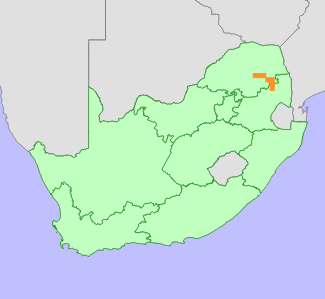|
Scientific Name | Lasiosiphon polyanthus (Gilg) C.H.Wright var. microcalyx Burtt Davy |
Higher Classification | Dicotyledons |
Family | THYMELAEACEAE |
Common Names | Escarpment Silver Yellow-head (e) |
National Status |
Status and Criteria | Least Concern |
Assessment Date | 2015/07/02 |
Assessor(s) | L. von Staden |
Justification | A range-restricted (EOO 2343 km²) taxon, and known from only a few records, but possibly overlooked due to taxonomic confusion. Some subpopulations are threatened by habitat loss and competition from alien invasive plants, but the majority of subpopulations are well-protected in an extensive range of nature reserves in Limpopo and Mpumalanga, and it is unlikely to be in danger of extinction. |
Distribution |
Endemism | South African endemic |
Provincial distribution | Limpopo, Mpumalanga |
Range | Wolkberg to Blyde River Canyon. |
Habitat and Ecology |
Major system | Terrestrial |
Major habitats | Grassland |
Description | Montane grassland and open woodland, often near streams. |
Threats |
| This taxon may have lost some habitat to timber plantations on the escarpment north of Graskop in the past, but plantations are no longer expanding, and remaining grasslands along the Blyde River are well protected. One subpopulation is possibly threatened by expanding rural settlements and subsistence agriculture outside of the borders of the Blyde Canyon Nature Reserve, but represents only a very small proportion of the population. It is also potentially threatened by spreading, unmanaged alien invasive plants in parts of the Wolkberg range. |
Population |
Population trend | Stable |
Notes |
| This taxon disappeared off South African checklists when the genus Lasiosiphon was transferred to Gnidia (Peterson 1959), but it was neglected to make a combination for this name in Gnidia. It re-emerged when Lasiosiphon was reinstated (Beaumont et al. 2009), but remains poorly known due to still unresolved taxonomic confusion in the genus, and is often misidentified as Lasiosiphon splendens (as in Schmidt et al. 2002). It is not similar to typical Lasiosiphon polyanthus, a species from central and southern KwaZulu-Natal, and their distributions are disjunct, and therefore this taxon quite likely warrants recognition as a separate species. |
Assessment History |
Taxon assessed |
Status and Criteria |
Citation/Red List version | | Lasiosiphon polyanthus (Gilg) C.H.Wright var. microcalyx Burtt Davy | Least Concern | 2015.1 | |
Bibliography |
Beaumont, A.J., Edwards, T.J., Manning, J., Maurin, O., Rautenbach, M., Motsi, M.C., Fay, M.F., Chase, M.W. and Van Der Bank, M. 2009. Gnidia (Thymelaeaceae) is not monophyletic: taxonomic implications for Thymelaeoideae and a partial new generic taxonomy for Gnidia. Botanical Journal of the Linnean Society 160(4):402-417.
Burtt Davy, J. 1926. A manual of the flowering plants and ferns of the Transvaal with Swaziland, South Africa. Part I. Pteridophyta to Bombacaceae. Longmans, Green and Co. Ltd., London.
Peterson, B. 1959. Some interesting species of Gnidia. Botaniska Notiser 112(4):465-480.
Schmidt, E., Lotter, M. and McCleland, W. 2002. Trees and shrubs of Mpumalanga and Kruger National Park. Jacana, Johannesburg.
|
Citation |
| von Staden, L. 2015. Lasiosiphon polyanthus (Gilg) C.H.Wright var. microcalyx Burtt Davy. National Assessment: Red List of South African Plants version 2024.1. Accessed on 2025/11/12 |
 Comment on this assessment
Comment on this assessment

